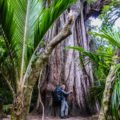Wild Law: Our Social Constructs
Holly W.R. | February 10, 2015.
The first part of this series introduced the concept of ‘wild law’ – a relatively new legal approach seeking to make natural entities the subjects of legal protection in their own right. Conventional, established legal systems often provide very restrictive environmental safeguards. Sitting against this backdrop, the wild law philosophy is starting to show, in practice, just how far the law can go in environmental protection, and the ways we can get there.
The examples below demonstrate the enormous potential of this project. From individual animals, to whole landscapes, even the biosphere – harnessing stronger, more comprehensive legal protection for the environment is entirely possible.
Animal rights – Tilikum case, United States
The Tilikum case sought to extend the US constitutional right to freedom from slavery to nonhuman animals. Brought by PETA against Seaworld in 2011, the case turned on whether orcas could be considered legal ‘persons’. While the court rejected this notion, it chose to avoid the question of whether that term could be extended or reinterpreted.
Arguably, strong US precedent supports the potential for recognising the legal personhood of nonhuman animals, and this case can be seen as a first significant step towards change.
Landscape rights – Whanganui River, New Zealand
In a landmark agreement, legal personhood has been extended to the Whanganui River in New Zealand. This means that in any legal challenge, the river itself is recognised as having rights and interests. Both parties to the agreement (the Whanganui River iwi [tribe] and the NZ government) have been deemed to be the river’s legal guardians.
As well as demonstrating the viability of extending legal standing to a natural entity, this agreement is a critical step in recognising the enduring relationship between the river landscape and its indigenous custodians.
Community rights – Community Environmental Legal Defense Fund (CELDF), United States
The CELDF helps communities in the United States to assert their rights to self-government of their local environments. This is achieved by passing council by-laws, or Community Bills of Rights, and holding these up against state, federal and corporate law. The goal of the CELDF is not to win cases (as this is unlikely, given the relative subordinacy of local laws), but to publicly expose how the law overrides community and environmental concerns in favour of corporate interests, even where they are articulated in the most legally transparent way possible.
Communities across the country have since succeeded in banning natural gas drilling, aquifer depletion and factory farming in their townships.
Constitutional rights – Vilcabamba River, Ecuador
In 2011, a case was brought on behalf of the Vilcabamba river, to uphold the ‘rights of nature’ clause in the Ecuadorian Constitution, after rocks and debris were dumped in the waterway by a local council. It was the first case to test article 71, which gives nature the right to ‘existence and for the maintenance and regeneration of its life cycles, structure, functions and evolutionary processes’.
After two local representatives successfully sought a constitutional injunction, the Provincial Court of Loja ordered the local council to rehabilitate the area within thirty days, and to prevent any damage in future.
International rights – Ecocide, UN
A campaign has recently been launched to include ‘ecocide’ in the Rome Statute, alongside genocide and crimes against humanity as the fifth international crime against peace. Ecocide was reportedly intended to be included in the original Statute, but disappeared from later drafts without explanation. Such a law would prohibit extensive damage to ecosystems, and would create a legal duty of care for nations to provide assistance to those experiencing naturally occurring ecosystem loss. The International Criminal Court (ICC) could then prosecute offending individuals and corporations. Reform will require amendment of the Rome Statute by a State willing to table the issue, and agreement by two-thirds of the remaining signatories. A willing state is yet to step forward.
Ultimately, law is a social construct.
It merely gives form and substance to the standards we set for ourselves and the world around us. When those standards are low, so too is our ability to provide active protection. But where the atmosphere is right, a change in the law – whether sourced in a new piece of legislation or a landmark court decision – can send a shockwave through society. It can realign the foundations of our understanding.
For too long, legal systems have merely mirrored the oversights of modern societies with respect to our environments. Wild law may just be the next big thing to challenge the way we look at our place in the world, and its place around us.













comment